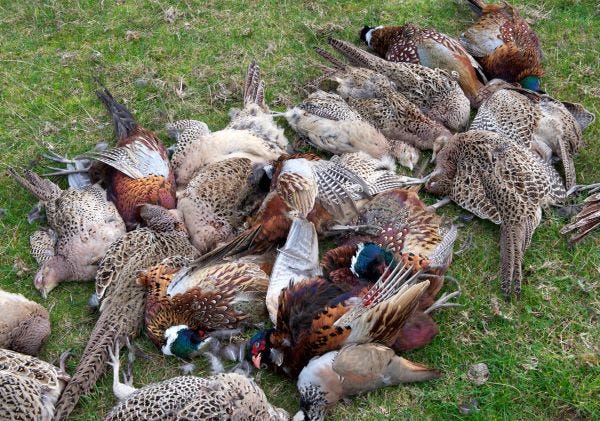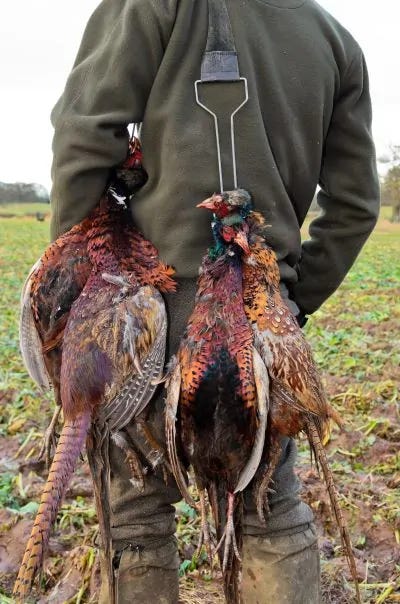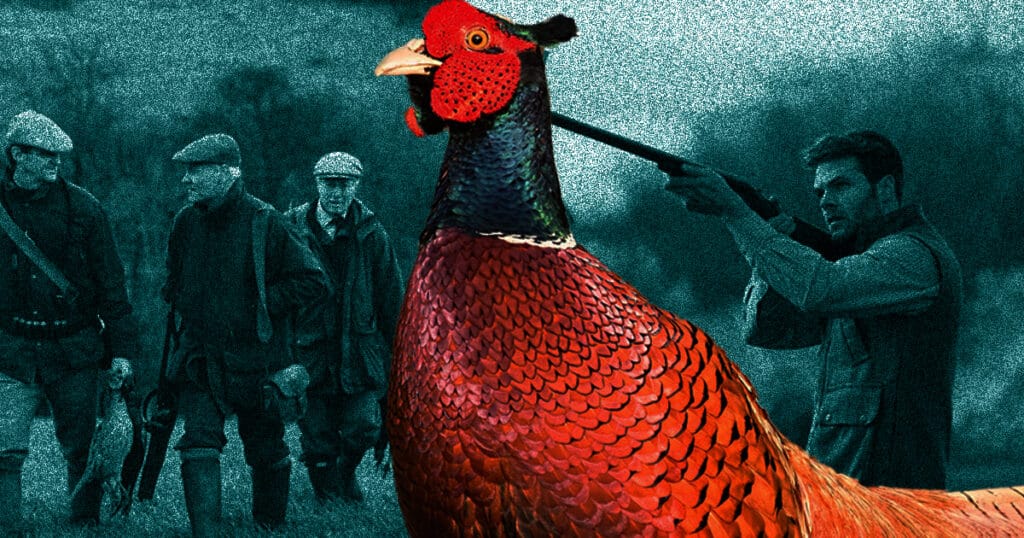Without any of the ludicrous fanfare surrounding the ‘Inglorious 12th’ but with 100 times the number of birds involved, today sees the opening shots fired in ‘the pheasant shooting season’. In England, Scotland, and Wales the ‘season’ ends four months later on 01 February, a month earlier in Northern Ireland.
In that time millions of Common Pheasants will die. An incredible 40 MILLION pheasants – a beautiful bird but from East Asia and only on the British list as a ‘naturalised introduced species‘ – are reared and released for shooting dead.
The numbers are horrifying, but perhaps as disturbing is just how ‘normalised’ the shooting industry bloodbusiness has become. While there is not the palaver associated with the start of killing Red Grouse, look online and hotels, pubs, tourist hot spots, all manner of individuals and businesses, are advertising to shooters with a staggering indifference to the birds themselves. Websites are littered with references to ‘idyllic locations’, ‘peace and tranquillity’, and ‘beautiful surroundings’ as lures to shooting tourists to stay, eat, drink, and ‘make memories’ with them killing birds. There is neither empathy nor malice – just a strikingly unemotional pitch for a slice of the pie…
Advertising trends
A few weeks ago we wrote a post explaining how a new upgraded mapping system on the website worked and suggested that “we are seeing some very interesting trends that we think make the whole project even more useful than a list of businesses and where they are.”
One of those trends is the topic of this post: the normalisation of killing birds on an industrial scale. In other words, how unremarkable or commonplace advertising birds to shoot has become.
In that post we said we’d listed 450 businesses. In the last week we’ve added another sixty. Many of them are related to shooting. Every single one of those driving home how utterly detached business owners (or their copywriters) are from the shooting dead of literally millions of birds. They make no excuses. There is no self-reflection (at least not evidently so). There seems to be no ethical consideration. There is simply money to be made selling birds, log fires, and catering to ‘shooting parties’ and they want their cut…

The mundanity of shooting pitches
The competition is so fierce in this highly commercialised world of shooting, that shoots clearly want to suggest they are better than their rivals or offer something extra. Yet they all read the same way. Neither distinct nor as different as they want to appear. The same ‘entertainment’, the same ‘tradition’, the same ‘sport’. There are only a handful of ways you can describe killing birds while still trying to sound ‘decent’, but read enough of these websites and they all start to sound like market stall hucksters shouting to be heard above other market stall hucksters. “How many birds for a grand for you and your mates? Not 50, not 100, not 150, but 200, that’s right gents, 200 luverrrlyyy birds between you…And all top quality!”
Shropshire’s Apley Estate for example says it “retains the high quality of sport and entertainment that it has been renowned for over a century.” Kent’s Glassenbury shoot offers “driven pheasant shooting of the highest quality.” Devon’s Loyton Estate sounds a little like an advert for a Rolls Royce or Bentley, offering “the pinnacle of game shooting experiences in the UK, where tradition meets luxury and excellence.” Not far away the Endsleigh Shoot offers “an outstanding spectrum of high-bird drives with picturesque pegs along the River Tamar.” Several hundred miles away Swinton Estate “provides an exceptional habitat for various species of gamebirds.” Eskdale Shooting Services promises to provide “some of the best quality driven Partridge and Pheasant shooting available anywhere in the UK.” In Ayrshire, Sorn Castle indulges in flights of fancy saying “The ancient dell provides a quiet space to contemplate the anticipation and excitement before a rush of birds distract“, while in the same county Carnell Estates even uses a pheasant in its branding while adopting a scattergun approach to appeal to as broad a customer as possible: “can be rented for exclusive use including corporate think tanks, product launches, bespoke wedding parties, golf groups and shooting.”
Kinloch House in Perthshire wants us to think that what really matters about Scotland is that it “is renowned for shooting, stalking and hunting.” An entire country boiled down to killing wildlife… Kinloch offers “first class wing shooting with driven pheasant and grouse, rough shooting, woodcock [a Red-listed bird of conservation concern in the UK] and some unbelievable goose shooting.”
One description that has particularly stuck with us is from the website of The Retreat at Elcot Park in Berkshire which promises “a top-tier day of shooting pheasants in the Kennet Valley” then creates the sort of shudder-inducing image that could only appeal to someone who enjoys a day out killing wildlife by promising a “deep, mural-coated tub winking at you back at base, as you peel off those sweaty plus fours.”
Then there’s Brynkinalt Estate in Clwyd, which has one of the most disingenuous paragraphs on shooting we’ve ever read: “We run a small commercial pheasant shoot based on traditional values with countryside conservation at its core. Parties stay in Brynkinalt Hall, having the chance to enjoy a house party with close friends.” It’s like ‘shooting bingo’ really. And never mind the killing, have a party…
…and certainly don’t stop to think about the piles of dead birds that are the result of these lookalike offers being taken up.

Shooting parties
Shooting long ago saw an opportunity to sell its product in the same way. Chums getting together for a day of ‘sport’ and evenings of drinking. High-profile golf venues like Gleneagles, the only golf venue in Europe to have hosted both the Ryder and Solheim Cups, offer the course alongside shooting. It describes itself as “a charming country estate, a rural family adventure, an invigorating escape for friends” with “a shooting and fishing adventure for every ability.” Turnberry, now owned by the first former American president to be convicted of felony crimes, is even more overt. “Trump Turnberry is delighted to offer exclusive hunting packages for groups of between two and nine hunters…our hunting experience includes high quality driven birds, walked up mixed game shooting and famous Galloway Red Stags on superb private estates.”
Hotels that might otherwise have nothing to do with shooting are waving hands in the air to attract the attention of the gun owner too. Somerset’s Lordleaze Hotel is typical, claiming that they “specialise in welcoming shooting parties…we are ideally suited to host your shooting party…End your day shooting with friends over a drink in our cosy, well stocked bar…”. The White Horse Hotel in West Sussex says it is “an ideal base for any shoot party” with “gun cabinets available, cigars at the bar, a wide selection of whiskies and fine wines and a full shoot host service.” Staffordshire’s Duncombe Arms offers a private dining room “if you want to catch up with your shooting friends over a convivial dinner after your day”. Devon’s Rising Sun reckons it is “the perfect base for parties to relax after a day’s shooting. You can enjoy your favourite tipple or something from our comprehensive wine list in our homely public bar with roaring log fires, or reminisce about your day’s shooting with your friends in our private shoot lounge.”
And on and on it goes. Incomprehensible to many of us, but a market has been created, and venues want in on it, serving themselves up as a place where ‘tired’ shooters can unwind and brag over whisky and wine about the hundreds of birds they spent the day killing. Not the lives they just took, nor the suffering they just took part in, not the noise, the traps and snares they don’t think about. Just a happy recounting of blowing pheasants, partridges, or pigeons out of the air while they’re slapping each other’s backs in the hotel bar afterwards.

Can things change?
But shooting is not ‘normal’. And certainly not on the industrial scale we see in the UK now, where millions of birds are released into the environment every year, ‘protected landscapes’ are run as gun clubs, and a catering company on the edge of the North Yorks Moor national park can say with (we assume) a straight face that they “supply served lunches in moorland lunch hut locations complete with beautiful table linen, exemplary experienced and discreet service staff, fine food that is beyond expectation and at a competitive price that adds to that special day in the field.”
Shooting has had a ‘golden age’ in the past few decades, operating hand in hand with a government that at best didn’t care and at worst colluded with shooting industry influencers, but what shooting has put in place can be dismantled.
The industry may still be flooding one of the most nature-depleted countries on earth with around 40 million pheasants and 10 million non-native partridges every year, but we’re increasingly aware that animals are capable of suffering and more and more of us see flogging them off as live targets as morally indefensible. We are increasingly aware of the biodiversity crisis and the role shooting estates could play if rewilded. We know how bad for wildlife and the environment the lead shot that shooting refuses to give up really is. We know for a fact that shooting is responsible for raptor persecution and we are grappling with the enormous scale of trapping and snaring it carries out. More and more of us are rebelling against being shut out of huge areas of the countryside just so that shooters can kill birds.
We are better informed, we are getting better organised, and we are exposing these activities more and more.
It might seem daunting, to be faced with a bloodbusiness as commercially organised as shooting, but industries come and go. Trends become hyped then ‘so last year’ then are gone. Arguments used to defend shooting, with their echoes of the US’s alt-right lashing out at ‘woke’ and trumpeting ‘freedom’, already sound childish, mundane, and old-fashioned. Shooting is undoubtedly enjoying itself right now, but it’s not so long ago that doctors promoted cigarettes as health products, that racist jokes were told on prime-time TV, and that driving home ‘a bit squiffy’ was just what ‘the Major’ did after a night in the pub. None of them survived scrutiny and shifts in public attitude.
We can fight back. We can keep saying that ‘seasons’ to kill birds are not ‘normal’. Rearing and releasing millions of birds to be used as live targets is not acceptable. Using protected places like national parks as shooting galleries is not acceptable. Shooting Red listed, conservation priority species like Woodcock and Common Snipe is neither ‘normal’ nor acceptable. And callously commercialising the slaughter of millions of birds is not ‘normal’…

